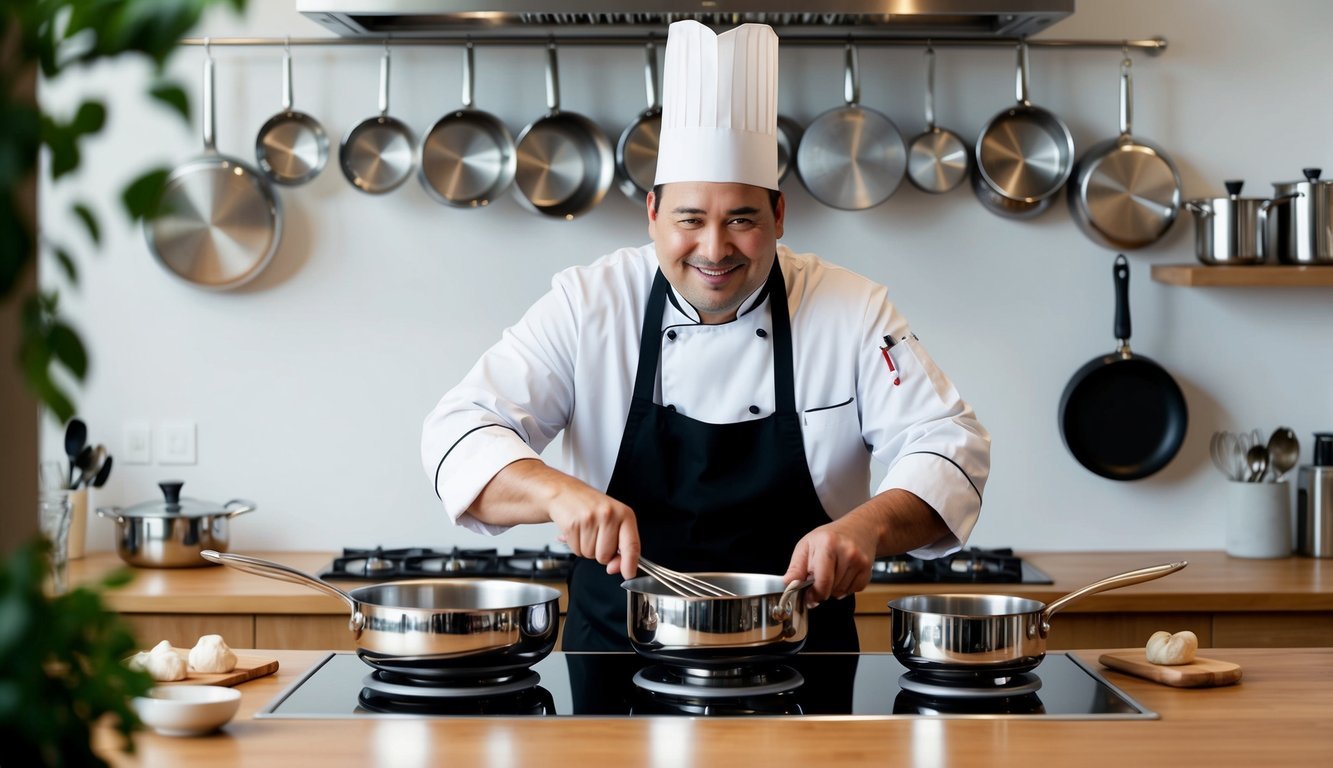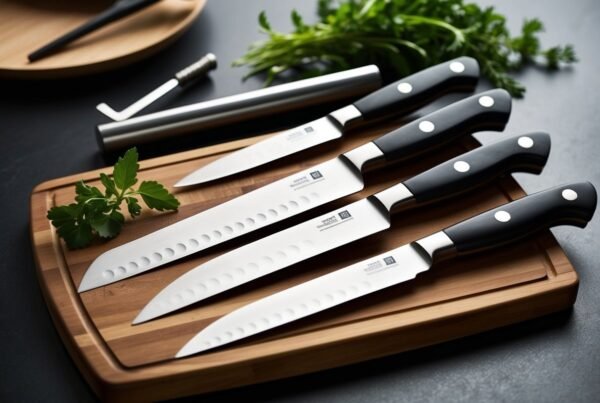High-end stainless steel cookware represents a significant investment in your kitchen’s future. Professional chefs and home cooks alike trust these premium tools for their exceptional durability and superior cooking performance. All-Clad’s D3 and D5 cookware sets rank among the most trusted options, known for their superior heat distribution and professional-grade construction.

Quality stainless steel cookware sets feature multi-layer construction that combines the best properties of different metals. The 3-ply and 5-ply designs sandwich aluminum or copper cores between stainless steel layers, creating pots and pans that heat evenly and respond quickly to temperature changes.
Premium cookware brands like Cuisinart and Made In offer excellent value while maintaining professional standards. These sets often include essential pieces like saucepans, stockpots, and skillets with sturdy handles and tight-fitting lids.
Key Takeaways
- Premium stainless steel cookware combines durability with superior heat distribution for optimal cooking results
- Multi-layer construction with aluminum or copper cores ensures even heating and temperature control
- High-end cookware sets represent a long-term investment that can last for decades with proper care
History and Evolution of Stainless Steel Cookware

Stainless steel cookware transformed kitchen practices since its invention in the early 20th century. The material’s durability, safety, and resistance to corrosion made it a top choice for home cooks and professional chefs.
Inception of Stainless Steel Cookware
Stainless steel was first invented in 1913 by Harry Brearley in Sheffield, England. His discovery that adding 12% chromium to steel created a rust-resistant metal sparked a cooking revolution.
The first major advancement came in 1928 when stainless steel vessels passed strict hygiene tests for beer fermentation. This success proved the material’s safety for food contact.
By the mid-1900s, stainless steel cookware reached homes worldwide. American manufacturers began producing high-quality 18/10 stainless steel pots and pans, with many family-owned businesses leading the charge.
Improvements and Innovations
Modern stainless steel cookware features tri-ply or multi-ply construction. This combines stainless steel’s non-reactive properties with aluminum or copper cores for better heat distribution.
The evolution of manufacturing techniques led to stronger welds, more comfortable handles, and better heat retention. Premium cookware now often features magnetic stainless steel bases for induction compatibility.
Made in the USA brands pioneered innovations like stay-cool handles, drip-free pouring rims, and ergonomic designs. These features, combined with 18/10 stainless steel’s natural resistance to scratches and stains, create cookware that lasts for generations.
Advantages of High-Quality Stainless Steel
Premium stainless steel cookware sets deliver exceptional performance and lasting value in the kitchen. High-quality stainless steel cookware made with 18/10 steel provides superior strength and corrosion resistance.
Durability and Longevity
High-end stainless steel pots and pans are built to last for decades with proper care. The 18/10 grade steel contains 18% chromium and 10% nickel, creating an incredibly strong and rust-resistant surface.
These pans won’t warp, scratch, or dent under normal use. Many premium brands back their cookware with lifetime warranties against manufacturing defects.
The cooking surface maintains its polished appearance over time and won’t react with acidic foods like tomatoes or citrus.
Heat Distribution and Retention
5-ply construction in premium cookware ensures quick and even heating across the entire cooking surface. The aluminum or copper core layers conduct heat efficiently while the stainless steel exterior provides durability.
Food cooks uniformly without hot spots that can lead to burning. The thick walls and base retain heat well, maintaining consistent temperatures when adding cold ingredients.
These pans excel at searing meats and creating fond for sauces thanks to their superior heat retention properties.
Versatility in Cooking
High-quality stainless steel can handle any cooking method from searing and sautéing to simmering and braising. The pans are safe for use on all cooktops, including induction.
They can go directly from stovetop to oven at temperatures up to 500°F. This versatility makes them ideal for recipes requiring multiple cooking techniques.
The non-reactive surface lets you cook any type of food without worry about metallic flavors or discoloration. These pans excel at deglazing and creating pan sauces.
Considerations for Choosing Stainless Steel Cookware
When selecting stainless steel cookware, the grade of steel, set configuration, and stovetop compatibility play crucial roles in making an informed purchase decision.
Material Composition
High-quality stainless steel cookware uses 18/10 grade steel, containing 18% chromium and 10% nickel. This combination provides excellent durability and corrosion resistance.
The chromium content prevents rust while nickel adds shine and strength to the cookware. Many professional-grade pots and pans feature a three-ply construction with an aluminum core.
This layered design ensures even heat distribution and prevents hot spots during cooking.
Cookware Sets versus Individual Pieces
Premium cookware sets typically include 8-10 pieces with essential items like saucepans, stockpots, and skillets.
Standard 10-Piece Set Contents:
- 8″ and 10″ frying pans
- 2-quart and 3-quart saucepans with lids
- 8-quart stockpot with lid
- 3-quart saute pan with lid
Buying individual pieces allows for customization based on specific cooking needs and kitchen space. This approach can be more cost-effective for those who only use certain types of pans regularly.
Induction Compatibility
Modern stainless steel cookware often features magnetic steel bases for induction stovetop use. Look for the induction-ready symbol or test with a magnet before purchasing.
The magnetic base layer must be thick enough to create proper contact with the induction surface. This ensures efficient heat transfer and prevents hot spots.
Quality induction-compatible cookware works equally well on all other cooktop types, making it a versatile choice for any kitchen.
Top Brands and Manufacturers
Several cookware manufacturers stand out for their exceptional quality and craftsmanship in stainless steel cookware production. These companies have built their reputations through decades of innovation, superior materials, and precise manufacturing techniques.
All-Clad and Its Reputation for Quality
All-Clad leads the high-end cookware market with their award-winning D5 and D3 collections. Their products are made in Pennsylvania using American-sourced steel and aluminum.
The company’s signature bonded construction process creates pans that heat evenly and last for generations. Their D5 line features five layers of metal, while the D3 series uses three layers.
Professional chefs and home cooks praise All-Clad’s key features:
- Superior heat distribution
- Stick-resistant cooking surface
- Oven-safe up to 600°F
- Dishwasher-safe design
International Craftsmanship: Mauviel and Le Creuset
Mauviel, founded in 1830 in Normandy, France, creates professional-grade stainless steel cookware with copper cores. Their M’Cook line combines traditional French craftsmanship with modern 5-ply construction.
Le Creuset, while famous for enameled cast iron, produces premium stainless steel cookware with tri-ply construction. Their pots and pans feature ergonomic handles and rolled rims for drip-free pouring.
Innovative American Brands: Made In and 360 Cookware
Made In’s 10-piece stainless set represents a new generation of American cookware. They use 5-ply construction and partner with family-owned manufacturers in the US and Italy.
360 Cookware stands out with their vapor-seal technology. Their pans are manufactured in Wisconsin using T-304 surgical-grade stainless steel.
Manufacturing highlights:
- Made In: 5-ply construction
- 360 Cookware: Waterless cooking capability
- Both: Lifetime warranties
Understanding Multiply Cookware

Multiclad cookware combines multiple layers of metal to create pots and pans with superior cooking performance. Each layer serves a specific purpose in heat distribution and durability.
Benefits of Tri-Ply Stainless Steel
Tri-ply stainless steel cookware features three bonded metal layers – stainless steel on the outside, aluminum core in the middle, and stainless steel on the cooking surface.
The aluminum core conducts heat quickly and evenly across the entire cooking surface. This prevents hot spots that can burn food.
The outer stainless steel layers add durability and make the cookware compatible with all stovetops, including induction. The cooking surface is non-reactive and won’t affect food flavors.
Key Benefits:
- Even heat distribution
- Excellent durability
- Works on all stovetops
- Non-reactive cooking surface
Comparing Layers: Tri-Ply versus 5-Ply
5-ply cookware adds two extra layers of metal compared to tri-ply construction. The additional layers create better heat retention and more even cooking.
Premium 5-ply cookware heats up more slowly but maintains consistent temperatures. This makes it ideal for dishes that require precise temperature control.
The trade-off comes in weight and cost. 5-ply pans weigh more and cost significantly more than tri-ply options.
Construction Comparison:
- Tri-ply: 3 layers, lighter weight, faster heating
- 5-ply: 5 layers, better heat retention, more expensive
Caring for Stainless Steel Cookware
Taking proper care of stainless steel cookware helps maintain its quality and cooking performance for decades. Regular cleaning and the right cleaning products make a big difference in keeping pots and pans looking new.
Cleaning and Maintenance
Proper daily cleaning prevents buildup and keeps cookware in top shape. Hand washing with warm water and mild dish soap is best, even for dishwasher-safe pieces.
Let pans cool completely before cleaning to prevent warping. Use a soft sponge or cloth – never steel wool or abrasive scrubbers that can scratch.
Store pans carefully by placing protective layers between them when stacking. This prevents scratches and maintains the polished finish.
Using Bar Keepers Friend
Bar Keepers Friend is excellent for restoring stainless steel cookware to its original shine. Make a paste with water and gently rub in circular motions.
This mild abrasive cleaner removes:
- Stuck-on food
- Discoloration
- Water spots
- Heat marks
Apply light pressure and rinse thoroughly. For tough stains, let the paste sit for 1 minute before scrubbing. Use Bar Keepers Friend monthly to maintain the finish.
Cookware Essentials for the Home Chef

Investing in high-quality stainless steel cookware gives home chefs the right tools to create professional-level meals. A well-planned collection includes key pieces that handle different cooking methods and serve multiple purposes.
Must-Have Stainless Steel Items
A 10-inch stainless steel frying pan serves as the cornerstone of any kitchen. Its flat bottom and sloped sides make it perfect for searing, sautéing, and pan-frying.
A 3-quart saucepan with a tight-fitting lid handles everything from cooking grains to making sauces. The All-Clad tri-ply construction ensures even heating and prevents hot spots.
An 8-quart stockpot proves essential for soups, stocks, and pasta. Look for sturdy handles and a heavy bottom to prevent scorching.
Building a Versatile Cookware Collection
Start with a 5-piece set of basic items that includes a skillet, saucepan, and stockpot. Add pieces gradually based on cooking needs.
A 3-quart sauté pan with straight sides and a lid bridges the gap between a skillet and saucepan. Its wide surface area works well for reducing sauces and braising.
Consider these key features when selecting pieces:
- 5-ply construction for durability
- Oven-safe handles
- Comfortable grip
- Induction-compatible base
Comparing Stainless Steel with Other Materials
Different cookware materials each bring unique qualities to the kitchen. The right choice depends on cooking style, maintenance preferences, and budget.
Nonstick versus Stainless Steel
Stainless steel cookware stands out for its durability and versatility in the kitchen. It excels at high-heat cooking and can go from stovetop to oven safely.
Nonstick pans work best for delicate foods like eggs and fish. They need less oil for cooking, but the coating can scratch and wear out over time.
The temperature range differs significantly. Nonstick pans should stay below 500°F, while stainless steel handles extreme heat with ease.
Copper, Aluminum, and Cast Iron Considerations
High-end stainless steel often incorporates aluminum or copper cores for better heat distribution. Pure copper pots heat quickly and respond fast to temperature changes, making them ideal for precise cooking.
Cast iron retains heat well and adds iron to food. It needs regular seasoning but creates an excellent natural nonstick surface.
Aluminum heats evenly and costs less than other options. Many brands use it as a core material between stainless steel layers for improved performance.
Key differences between materials:
- Copper: Fast heating, expensive, requires polishing
- Cast iron: Heavy, great heat retention, needs seasoning
- Aluminum: Light, good heat conductor, can react with acidic foods
Innovative Features and Advanced Technologies

Modern high-end stainless steel cookware combines cutting-edge materials with smart design elements to enhance cooking performance and user comfort.
Heat Conductivity Solutions
Advanced tri-ply construction creates exceptional heat distribution throughout the cooking surface. The aluminum or copper core sandwiched between stainless steel layers eliminates hot spots.
Specialized base technology like flat-bottom designs prevents warping and ensures stability on all cooktop types, including induction.
Some premium brands use patented heat-conductive layers that extend up the sides of the pan, not just the bottom. This feature helps maintain consistent temperatures when cooking sauces or sautéing.
Ergonomic Designs for Comfortable Handling
Welded stainless steel handles provide superior durability and hygiene compared to riveted alternatives. The seamless construction eliminates food particle collection points.
Handles feature balanced weight distribution and ergonomic angles to reduce wrist strain during lifting and pouring. Many designs incorporate stay-cool technology to prevent burns.
Thoughtfully designed pour spouts and helper handles on larger pieces make transferring hot contents safer and easier. The helper handles are particularly useful for moving heavy pots filled with soups or stews.
Consumer Insights: Reviews and Ratings
Professional chefs and home cooks rate stainless steel cookware sets based on durability, heat distribution, and value for money. Top-rated sets consistently deliver excellent cooking performance while remaining easy to clean and maintain.
Identifying the Best Value Cookware Sets
The Cuisinart Chef’s Classic Stainless Steel 10-Piece Set ranks as a top budget-friendly option, offering quality construction at an accessible price point.
The All-Clad D3 Tri-Ply cookware stands out for its lifetime warranty and superior heat distribution. Many professional kitchens choose this set for its reliable performance.
The Tramontina Gourmet Tri-Ply Clad provides excellent value with its thick aluminum core and sturdy construction. Users praise its even heating and comfortable handles.
Leveraging Consumer Feedback for Informed Decisions
Test kitchen experts evaluate cookware through rigorous cooking tests, including:
- Braising meat
- Sautéing vegetables
- Simmering sauces
- Heat distribution checks
User reviews highlight the importance of:
- Pan weight and balance
- Handle comfort during extended use
- Ease of cleaning
- Lid fit and steam control
Professional reviews indicate that 5-ply construction offers better heat retention than 3-ply alternatives. Home cooks report greater satisfaction with heavier, multi-layered pans despite their higher cost.
The Environmental Impact of Cookware Production
Stainless steel cookware production creates significant environmental impacts through raw material extraction and manufacturing processes. Modern brands are working to minimize these effects through innovative production methods and sustainable practices.
Sustainability in Manufacturing
The production of high-end stainless steel cookware requires substantial energy for mining and processing raw materials. Many premium manufacturers now use recycled stainless steel to reduce their environmental footprint.
French heritage brands lead the industry in adopting energy-efficient manufacturing processes. These companies typically use closed-loop water systems and heat recovery technology in their factories.
Several manufacturers have achieved ISO 14001 environmental certification through waste reduction programs and responsible material sourcing.
Eco-Friendly Practices Among High-End Brands
Leading cookware brands now use minimal packaging made from recycled materials. Many include detailed care instructions to help products last longer, reducing the need for replacements.
Premium manufacturers offer lifetime warranties and repair services to extend product lifespan. This approach supports the durability-focused sustainability that makes high-end cookware a more environmentally conscious choice.
Some heritage brands maintain local production facilities to reduce transportation emissions. These facilities often feature solar panels and other renewable energy systems.
Companies increasingly use digital product documentation instead of printed materials, saving paper and reducing waste in everyday cooking use.
Frequently Asked Questions
Top stainless steel cookware features multi-layered construction with aluminum or copper cores for optimal heat distribution. Professional-grade pieces use 18/10 steel and have riveted handles that stay cool during cooking.
What defines high-end stainless steel cookware?
Five-layer construction with multiple metals creates superior heat distribution and durability. Premium cookware uses thick aluminum or copper cores sandwiched between stainless steel layers.
Heavy-gauge materials prevent warping and ensure even cooking temperatures. Quality pieces have perfectly smooth surfaces and precision-fitted lids.
What features should one look for when choosing the best stainless steel cookware set?
Look for fully-clad construction where the metal layers extend up the sides of the pans. Well-made handles should be securely riveted and stay cool during use.
The lids should fit tightly with no gaps. Pans need smooth rims for easy pouring and cleaning.
Which stainless steel grades are considered the highest quality for cookware?
18/10 stainless steel provides excellent durability and corrosion resistance for the cooking surface. The exterior often uses magnetic 400-series steel for induction compatibility.
Premium cookware combines these steel grades with aluminum or copper cores for optimal performance.
How do professional chefs select stainless steel cookware for their kitchens?
Professional chefs prioritize heat responsiveness and durability. They test how quickly pans heat up and cool down when temperature adjustments are made.
Weight and balance are crucial factors. The cookware must be heavy enough to sit flat but comfortable to maneuver during long cooking sessions.
What are the notable differences between popular stainless steel cookware brands?
All-Clad and Demeyere differ in construction methods and handle designs. Some brands focus on traditional riveted handles while others use welded attachments.
Pan thickness and core materials vary between manufacturers. Higher-end lines often feature copper cores while mid-range options use aluminum.
How does 18/10 stainless steel cookware compare to other types in the market?
18/10 steel contains 18% chromium and 10% nickel, creating a non-reactive cooking surface that resists corrosion. This composition maintains its shine better than lower-grade alternatives.
The high nickel content prevents rusting and improves durability. These pans can handle high heat and acidic foods without degrading.


